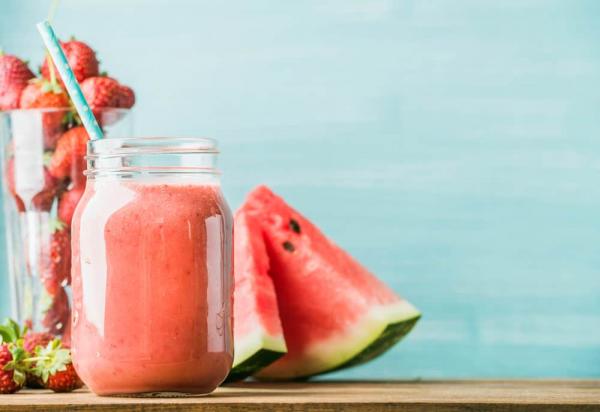
Smoothies are the best way to pack your family's morning with fruits, vegetables, and other nutrients, so the day starts off right. Smoothies are also a fantastic way to watch your waistline and focus on clean eating. After two straight years of daily smoothie consumption, here are some of my best smoothie secrets:
1. A good drink takes the edge off
Start with some liquid. Favorite liquids to include (just one at a time):
Milk, Almond Milk, fresh-squeezed orange juice, mango nectar, cold-pressed apple juice, cranberry-raspberry juice, or pomegranate juice. Use versions with no sugar added and stay away from frozen concentrates when possible. In a pinch, even 1/2 cup of cold water will help things blend nicely.
1/2 cup of liquid is plenty for a single-serving smoothie. For a family-size smoothie, use 1-2 cups.
2. Totally chill
One third of the total contents in the smoothie should be frozen, whether you use ice cubes or frozen fruit. This guideline applies to any smoothie recipe (or your own invention). Below are some examples so you can see just how easy it is to reach these proportions.
To 2 cups fresh fruit and veggies (your choice) add one cup of ice before blending.
To 3 cups juice, yogurt, and fresh fruit (your choice), add 1 1/3 cup frozen fruit (your choice) before blending.
3. What they don't know won't hurt them
Sneak in some veggies into your smoothies! If you disguise the flavor, no one will complain. Spinach and kale are winners here. Stave off any bitterness in the greens with a tablespoon or two of fresh lime juice. I also enjoy carrots, celery, cucumbers, and small amounts of cabbage in my smoothies. Balance quantities and colors (see below).
4. Fiber keeps you going (so to speak)
Fiber also helps you feel fuller longer, so the mid-morning munchies don't take hold before lunch. Of course fruits and veggies are loaded with fiber. For a bigger boost, try adding a tablespoon of ground flaxseed, which is high in fiber, tastes great, and you hardly know it's there.
Other high-fiber helpers (in addition to the fruits and vegetables we recommend) are wheat germ, old-fashioned oats (great in my banana-cashew smoothie), dates (also in my banana-cashew smoothie), figs, chia seeds, hemp seeds, coconut flour and fresh coconut meat.
And the secret fiber addition that will make your day: cocoa!
5. Power up with protein
Cottage cheese, Greek yogurt, peanut butter or almond butter, tahini, silken tofu, chia seeds, and avocado are all good choices to add strength to every sip. When in doubt, a mild-tasting protein powder will do the trick, but beware of stealth chemicals and artificial ingredients. I also love adding nuts to some of my favorite smoothies, such as almonds and cashews, for extra protein.
6. Sweeten the deal (carefully)
You and your family are much more likely to stick to a morning smoothie routine if it actually tastes good.
Of course, the best option is to sweeten naturally with sweet fruits like bananas, pineapple, etc. But when adding something tart like greek yogurt your smoothie may require additional sweeteners. Here are some great options to help sweeten up your smoothies:
Agave
This is not low-calorie but has a low glycemic index.
Honey
Again, this is not low-calorie, but slightly sweeter than sugar and is a natural antibiotic.
Stevia
Natural, low-calorie, but looks just like sugar when you buy the powdered version. Use half as much as you would sugar. It's doubly sweet.
Don't add any sugar, not even Turbinado or raw sugar (a common ingredient in many commercially produced smoothies).
What is worse still? Artificial sweeteners. Studies show that they can actually cause weight gain:
"[A]rtificial sweeteners, precisely because they are sweet, encourage sugar craving and sugar dependence. Here, researchers showed that saccharin and aspartame both cause greater weight gain than sugar, even when the total caloric intake remains similar." And then there's that nasty aftertaste.
7. Color-coordinating will help
As an artist, this is very logical to me. A brown smoothie is unappealing and looks like the sludge from the bottom of a riverbank. If you really want to keep up the smoothie regimen, it's gotta look good as well as taste good.
Never combine elements of complementary colors (opposite colors on the color wheel you may remember from elementary school). This means too much green can ruin a red smoothie; blueberries and mango mixed together will also give you brown. The exception: bananas (although yellow on the outside) are essentially white and will go with anything. And some fruits, like blackberries, are so dense and saturated in their color that you can still add green without your smoothie going brown on you.
Here are some great colorful combinations of fruits and vegetables:
1: Oranges, bananas, pineapple, mangoes, carrots
2: Green grapes, banana, kiwi, pineapple, spinach, avocado
3: Cranberry or pomegranate juice, mixed berries, red cabbage, red grapes, red beets (proceed with caution-the flavor is pretty strong.)
You get the idea. Mix and match. Experiment a little with flavors, colors and textures, and see what works for you.
Now, go blend yourself some morning sunshine and smoothie magic!

